A spiked riot of original architecture. A vintage boulevard where everyone speaks Spanish. The wellspring of the blues. The birthplace of house music. The way you think about Chicago depends entirely on which part of it you’ve been to.
The city of 2.7 million on Lake Michigan manifests as a collection of neighborhoods, each one a mini ecosystem, with its complementary restaurants and public spaces, denizens and habitats. And then, in the next neighborhood, everything all over again, only this time there’s a beach, and the taquerias have been replaced by German beer halls. Like the river that made it, the Windy City is different every time you set foot in it. The first time I visited Chicago, I was in awe of its surreal, hyperambitious restaurants. The second time, I was amazed by its towering, audacious buildings. The third time, a random guy invited me to his housewarming party. This is the story of the fourth time.
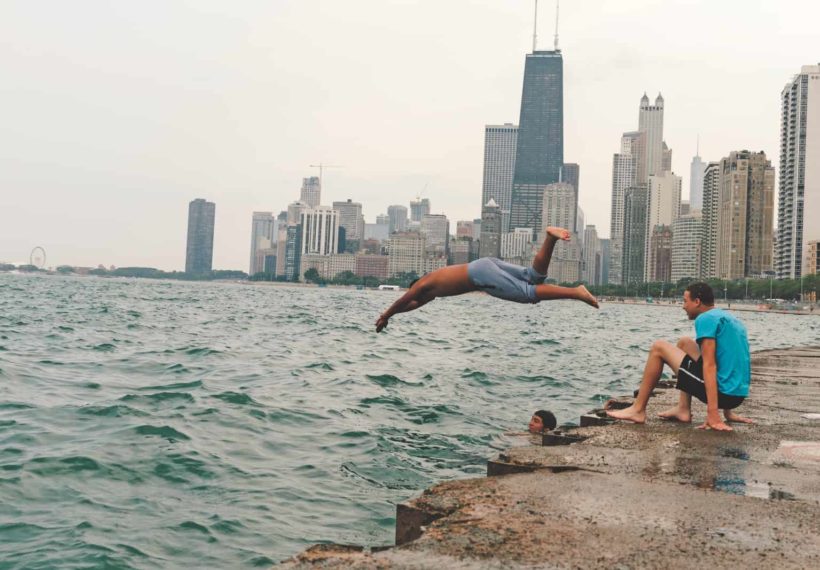
Day 1
Appreciating architecture and cheering on the Cubs
I am pretty sure that if you’re good in this life, when you get to the pearly gates, St. Peter hands you a kitten-soft robe from the Art Deco St. Jane hotel and says, “Here you go. This is what we all wear up here.” I was set to leave my moody Victorian suite (complete with interior brass stairwell!) and start my day, but I hadn’t counted on the heavenly perfection of this garment.
OK, fine, I’ll get coffee. The St. Jane is inside Chicago’s Loop, so named for the circuit the elevated subway system (called the L) travels around it. It’s about an eight-minute walk to Anish Kapoor’s Cloud Gate sculpture, which locals have nicknamed “The Bean.” Across from that, the cheeky Crown Fountain spits water into a reflecting pool at the edge of Millennium Park. I buy a Limitless Salted Caramel Cold Brew from Michigan Avenue’s Fairgrounds Coffee and Tea, which offers kombucha, cold brew, and even nitro matcha on tap, then walk across the sinuous BP pedestrian bridge to see Lake Michigan. Its endlessness always shocks me; today it fades into mist at its far edge.
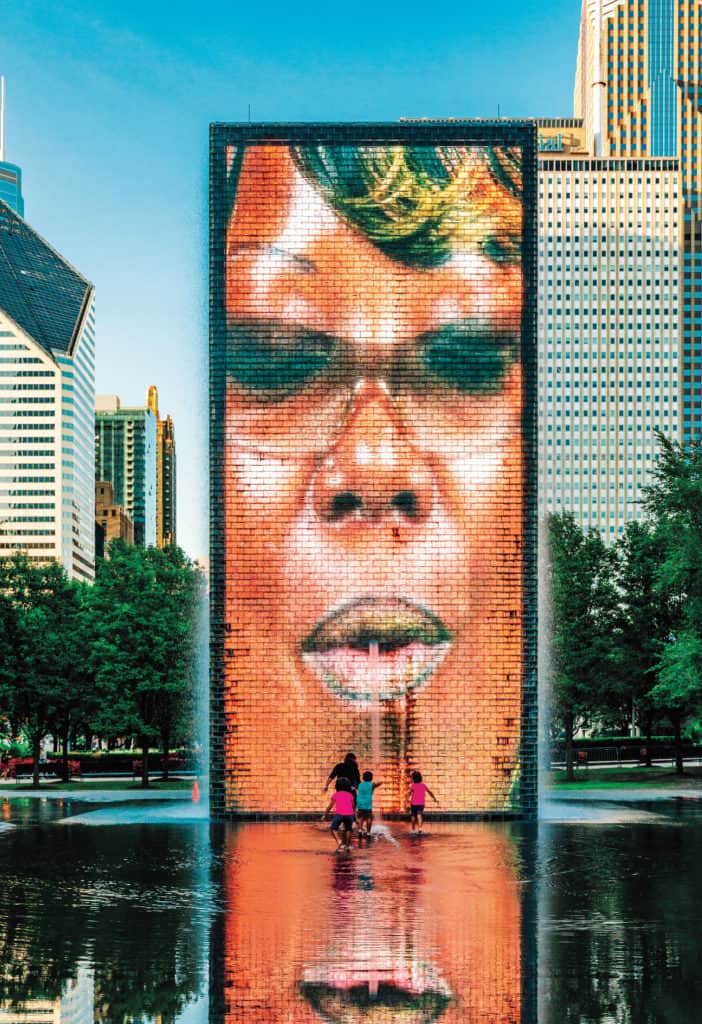
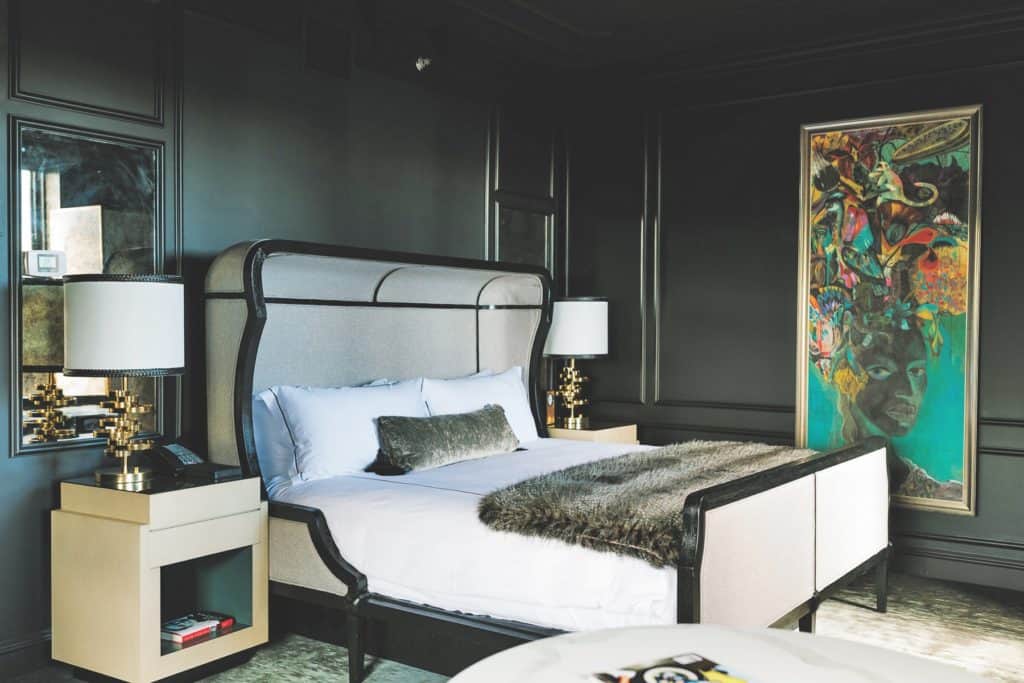
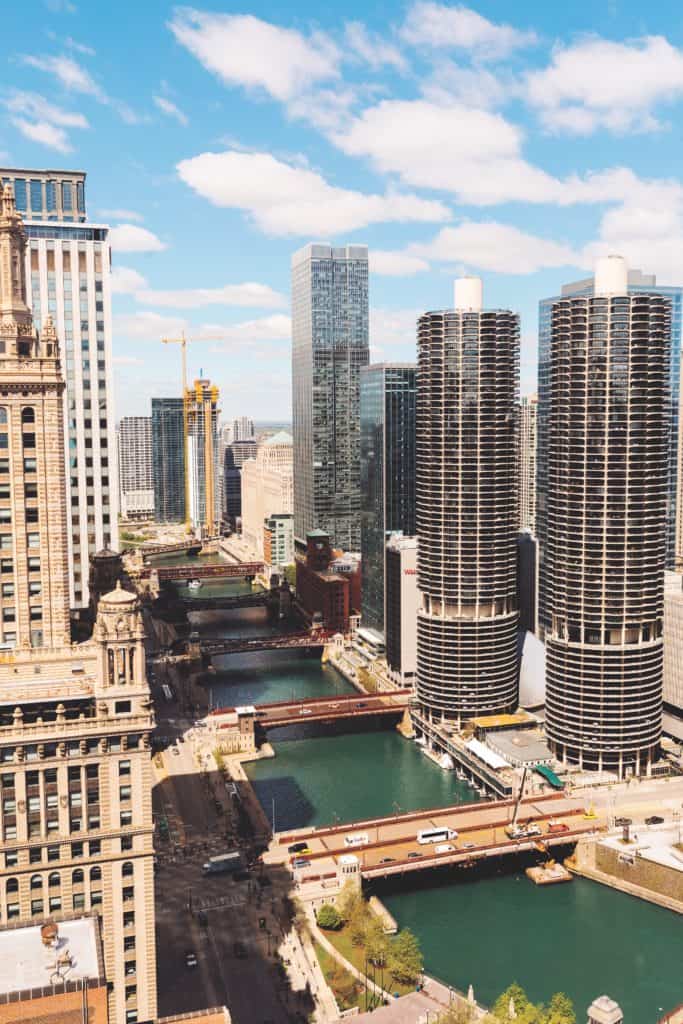
But Chicago is not all, or even mostly, the lake. The best way to get acquainted with the city is by river, on the Chicago Architecture Foundation Center River Cruise. From the top deck of the Chicago’s First Lady, downtown’s high-rises loom like the cliffs of a Utah canyon. We cross under bridges with just a few feet of leeway, learning how the city came to architecturally dominate the United States. Nancy, the volunteer docent leading the tour, fills in the cracks (OK, chasms) in my architectural education: In high-rises, the term spandrel refers to the space between the window tops on one floor and the sills above; the Great Chicago Fire of 1871 crossed the river because the water was full of wooden boats; yes, Art Deco buildings do kind of look like armchairs. We learn the similarities between Bertrand Goldberg’s 1963 Marina City, its lobes like the petals of a hippie’s daisy pin, and his 1986 River City, a Brutalist, organic cliff dwelling. We see 150 North Riverside, the ballerina, cantilevered over the river in defiance of God and physics. If I remember even half of what Nancy says, I’ll have dinner party factoids for years.
History reminds me of school, which reminds me it’s lunchtime. Chicagoans
can debate the merits of their favorite pizza for hours: Pequod’s is puffy and caramelized; at Gino’s East you can order your pie topped with a full-size sausage disc. Lou Malnati’s, which operates some 56 locations in the area, is a bit touristy, but it’s tasty (and ubiquitous) enough that I’m calling it in their favor. I order the Lou: spinach, garlic, basil, onion, three cheeses, mushrooms, and sliced Roma tomatoes. The classic deep-dish crust, which is yanked up the sides of the pan before going in the oven, is lighter and crispier than I remembered, the flavor deeper and more buttery. I’m a thin-crust girl at heart, but I could (unfortunately) eat a lot of these. I have to stop myself, though; I’ve got a game to catch.
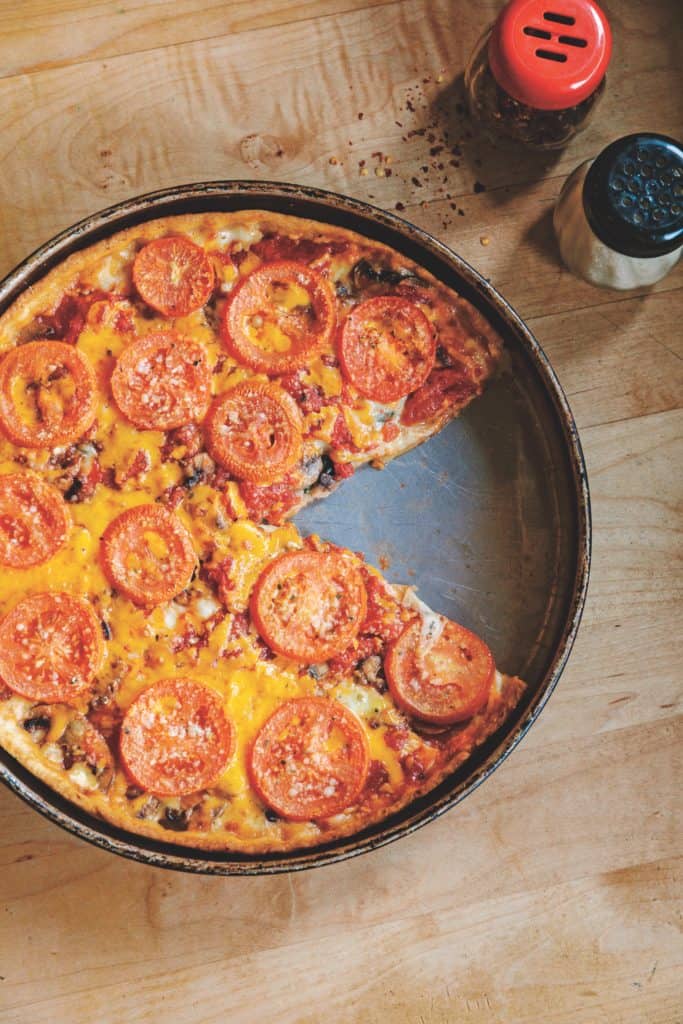
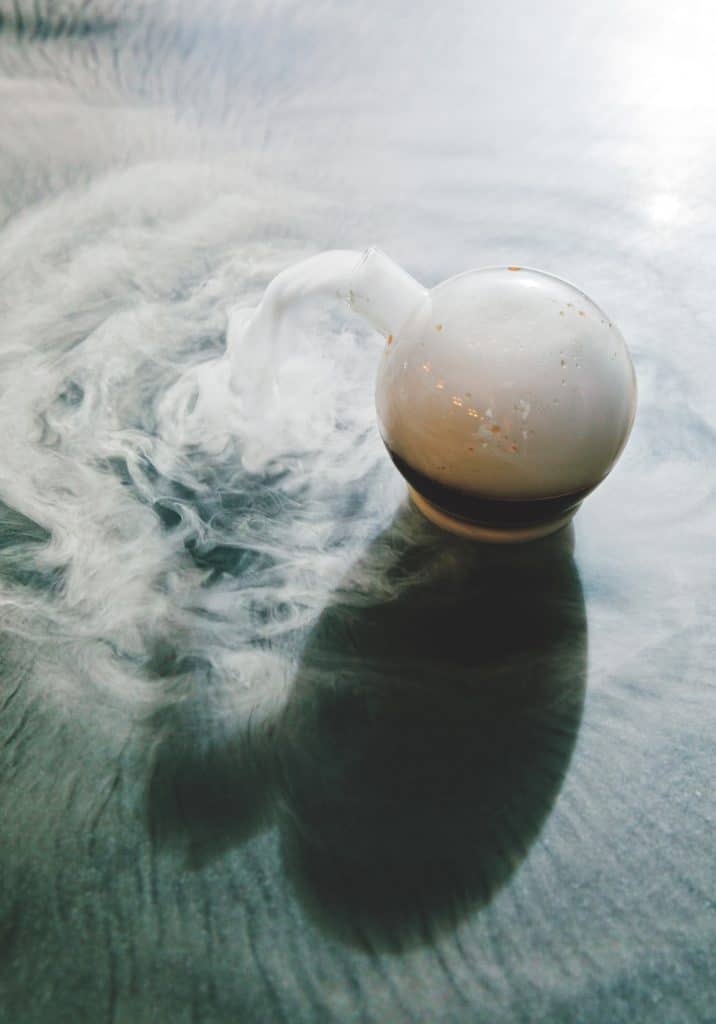
At 105 years old, Wrigley Field is one of the last remaining prewar ballparks in the country. (The only one that’s older is Boston’s Fenway, at 107.) It’s a true neighborhood park, with skybox-style bleacher seats topping some of the surrounding apartment buildings—but I’m headed to the cheap seats. On the way in, I pass a little boy and his sister playing an elaborate game of catch/dodgeball against one of the stadium’s walls, a lemonade stand sitting forgotten behind them. I’m peckish, so I head to the Garrett Popcorn kiosk and buy the local fave, a mix of caramel and cheese, and head to my seat.
I don’t quite get my Ferris Bueller moment—the only ball to make it into my section is caught by a guy a few rows over—but I do get to sing “Take Me Out to the Ball Game” during the seventh-inning stretch, following comedian Roy Wood Jr., who leads the chorus from the jumbotron. There are so many stats on the oldschool scoreboard it’s almost impossible to find the score. Who’s winning? Oh, the Cubs. Whew.
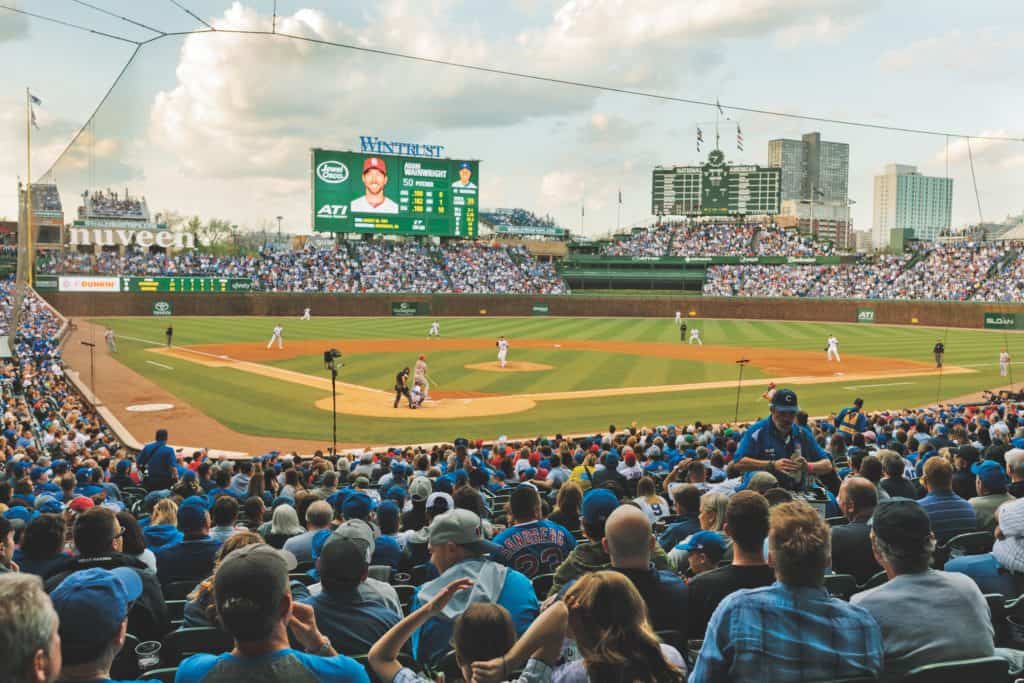
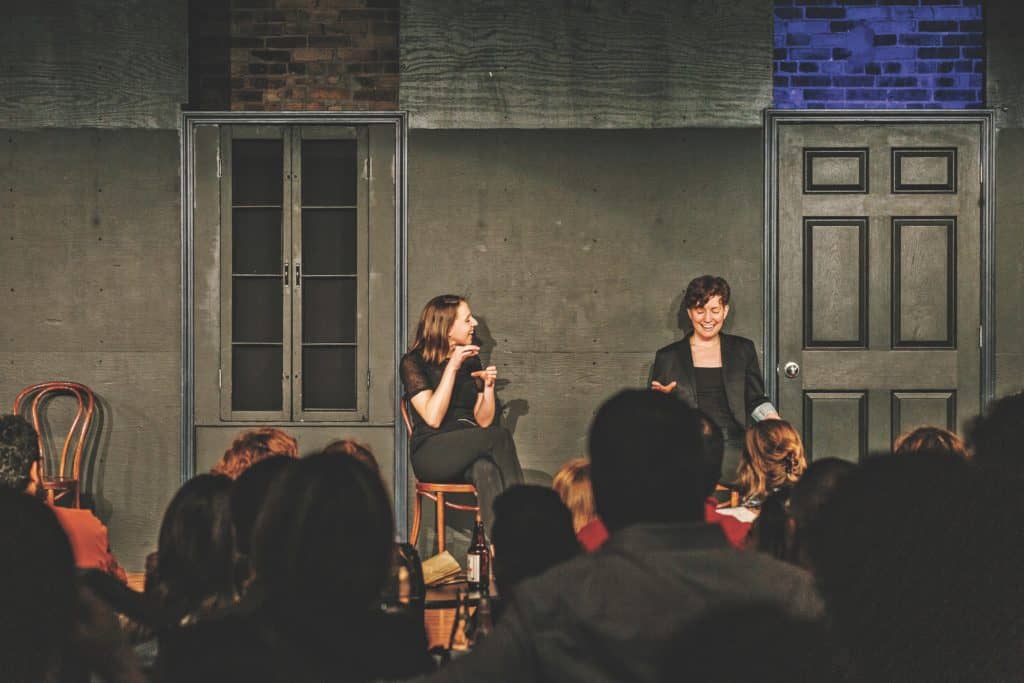
The game ends (Cubs 6, Cardinals 5) with just enough time for me to cab down to iO Theater, on a leftover patch of land between Old Town and Ranch Triangle, to experience Chicago’s storied improv scene. For this show, Whirled News Tonight, audience members are supposed to cut out their favorite articles from the day’s newspapers and tack them to bulletin boards while the lights are up. I select a story about hard times falling on Canada’s maple syrup industry, then sit back and order some wings and nachos, which seem in keeping with the day’s theme. When the show begins, the troupe turns the article I chose into a family meeting: “We’ve got to get millennials interested in maple syrup,” the father says in a ridiculous Canadian accent. They settle on putting the syrup in vape pens, and the audience is in tears anytime anyone says “Sooorry?”
The Aviary’s cocktails, produced with tweezers and smoking guns and sous vide baths, fizz and steam and melt.
Afterward, the comics mill around with friends and family, rehashing moments of exhilaration and terror. Surely one of these people will be the next Amy Poehler or Stephen Colbert (both iO alums). I’d stay to chat but I have one more stop before bed: The Aviary, the ultimate shrine to cocktail-making from obsessive chef-cum-scientist Grant Achatz. Inside a monochromatic sanctuary, Achatz’s chosen bartenders toil on the other side of a floor-to-ceiling fence. The cocktails they produce with their tweezers and smoking guns and sous vide baths fizz and steam and melt. My favorite is the Jungle Bird: rum, pineapple and lime juices, and Campari layered over a pile of liquid-filled gelatinous balls that pop in your mouth. “That one’ll get you,” says the host as I wobble out. “All those little balls are full of rum!”
Day 2
A South Side history lesson and a Fulton Market food tour
I’m back in the robe, and while there are many museums here worth getting out of it for—the Field Museum, with its titanosaur; the Art Institute of Chicago, with American Gothic—none is as deeply necessary as the Stony Island Arts Bank. The museum is an extension of the physical art of local creator Theaster Gates, who is trained in both ceramics and urban planning. Gates, whose Rebuild Foundation invests in the cultural redevelopment of underserved neighborhoods, found out the city was planning to demolish a beautiful South Side bank from the 1920s and convinced the government to sell it to him for $1. He refurbished it, creating a cultural space and museum dedicated to the experiences of black people.
Everything here is free and open to the public, including film screenings, live music, and DJ sets. An exhibition of Rob Pruitt’s Barack Obama paintings—quotidian portraits of the 44th president painted in white on red and blue canvases—fills the downstairs. The research library of Johnson Publishing, which was once the largest African-American-owned publishing company in the country and the creator of Jet and Ebony magazines, spans two floors and contains a comprehensive history of black culture in the United States. Inside the library, you can watch an archivist digitizing the collection of records belonging to Frankie Knuckles, the godfather of Chicago house music. There’s more, all of it powerful, but nothing screams the museum’s mission more than its Neoclassical facade, sitting alone on this long, desolate street. Where are the lines of patrons? Where are the passersby? I want to tell everyone about this place.
I get my chance in a cab, telling the driver, who has a lot of DJ friends, about the Frankie Knuckles collection. He’s so excited to visit that he has me spell the museum’s name for him. “You gotta listen to house,” he says, by way of a solution to just about everything. “The house music crowd doesn’t talk about killing. They just talk about partying and dancing and positive things.”
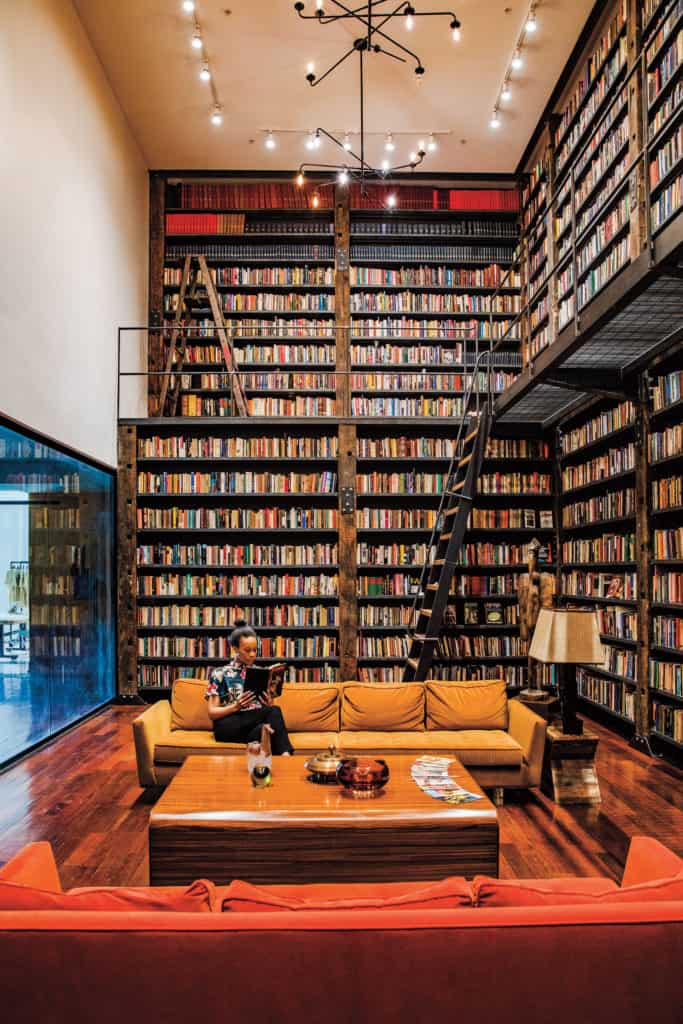
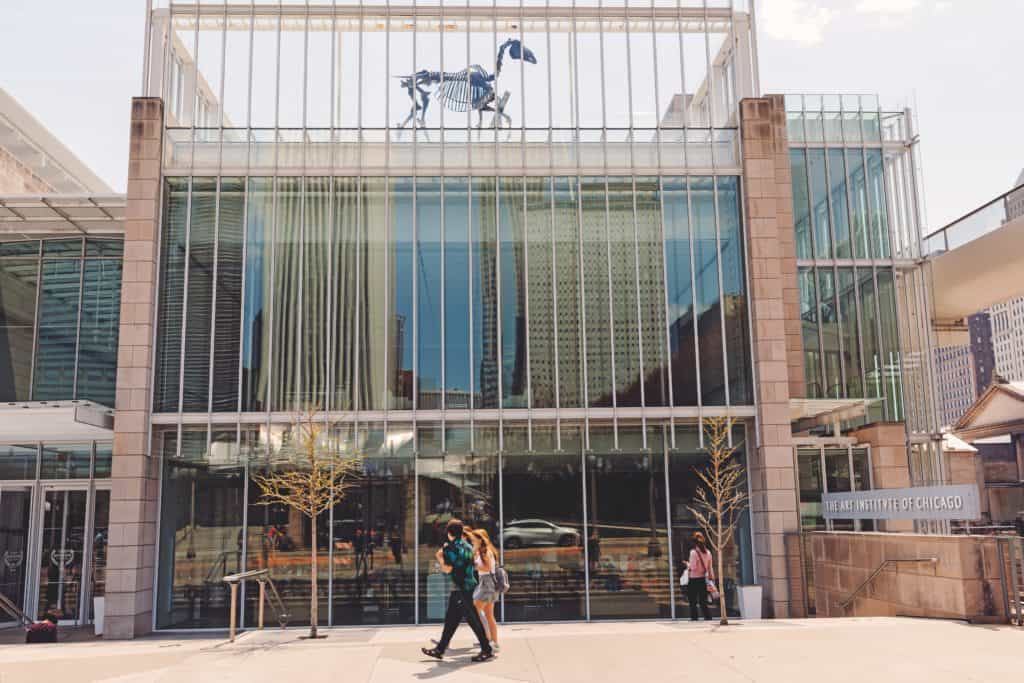
Speaking of partying and dancing and positive things, could my driver drop me off at The Hoxton, Chicago, in Fulton Market, so I can check in? The hip London-based mini-chain has a knack for anointing the just-hit-it-big neighborhood in every city it touches. Decked out in Mid-Century Modern furniture, with a window framing the tracks of the L, the lobby looks like a place where that absurd party from the Leonardo DiCaprio version of The Great Gatsby could break out at any moment.
Beloved Chicago chef Stephanie Izard has bestowed her latest restaurant, Cabra, a Peruvian cevicheria, on the Hoxton’s rooftop. And, wouldn’t you know it, here she is in the lobby, wearing her hair piled on top of her head the way she did while becoming the first woman to win Top Chef. Izard is insanely busy, overseeing four restaurants in Fulton Market, but as a de facto ambassador for the district, she has agreed to give me a tour. “When you’re trying to pick where to open a restaurant, you pick a neighborhood and you determine what your restaurant is going to be from there, because the neighborhoods are so different,” she says. “The day [my partner and I] came down to look at Fulton Market 10 years ago, none of this was here. It was kind of barren and empty and warehousey, and he was like, ‘All right, use your imagination and give this space a chance.’” Now, Izard says, the nabe has come up so much that it’s turned into “the restaurant epicenter of the city.” She might be a little biased.
Or maybe she isn’t. At our first stop, JP Graziano Grocery, we order a juicy Italian sandwich called the Mr. G to split, and I realize I am (oops) starving. The sandwich is rich and salty, with sharp provolone, hot soppressata, prosciutto, salami, basil, artichokes, and lettuce, on soft bread with zingy Italian spices and condiments. Izard introduces me to Jim Graziano, the founder’s great-grandson, who turned his family’s 82-year-old meat and grocery business into a sandwich shop in 2007 in anticipation of Fulton Market’s rise. “When I grew up, this neighborhood was all wholesale markets. At 2 p.m. you could shoot a cannon down Randolph Street and not hit anything,” he says, as the theme from The Godfather plays over the restaurant’s speakers. “I was just like, ‘This building is so cool, and this corner is right in the middle of everything.’ I saw an opportunity.”
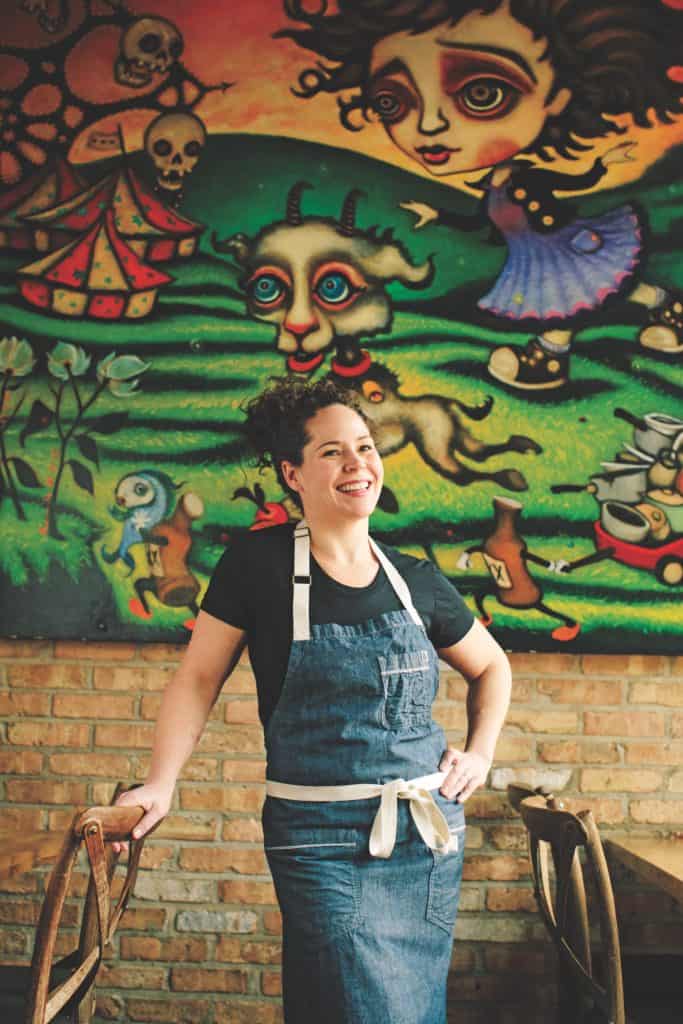
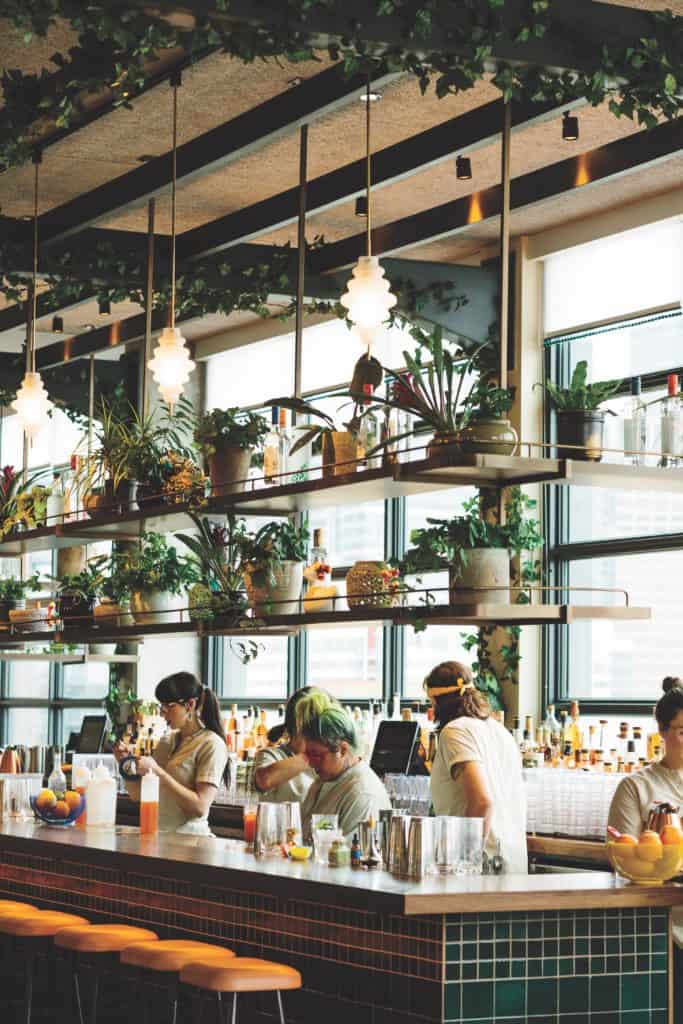
Izard says she has about 25 plants at home, and her 3-year-old son, Ernie, is going through a flower phase, so our next stop is Asrai Garden, which smells of forest floor and palo santo. I ogle the jewelry and candles while Izard pulls together a bouquet of bright red ranunculus, baby pink wax flowers, and what looks like lavender candytuft. The cashier wraps it all in black paper. “I feel like I’m in a wedding!” Izard says, gamely marching down the aisle and out the door.
On our way back to the hotel, we stop where balloons mark the spring reopening of Baobing, Izard’s Taiwanese street food takeout window, which is connected to her restaurant Duck Duck Goat. Izard wants to take a picture with the fans who waited in line, but first she orders me the Jian Bing Thing, an ice cream bar wrapped in a custard-coated crepe, with cilantro, hoisin caramel, and sweet and crunchy chili oil. It’s the most unexpected flavor combination I’ve ever experienced (and I drank a cocktail made out of Campari, pineapple juice, and rum balls last night).
Izard has to get ready for her evening, but I have one more shop to visit—the men’s clothing store Independence, which carries sophisticated floral shirts and vintage denim. After much convincing, it earned the right to import shirts from a Japanese brand called Kapital. My fiancé salivates over these things, and I’m always on the lookout for gifts.
I take the elevator up to Cabra, a breezy oasis decorated with carved llamas and bottles of pisco.
For dinner, I take the elevator to the roof and Izard’s Cabra, a breezy oasis decorated with leggy plants, carved llamas, bottles of pisco, and a rolling door leading to a pool. Looking at the menu, I immediately realize I don’t know a lot about Peruvian food. What is choclo? Huancaina? Tiraditos? A friendly waiter comes to my rescue: Choclo is giant Peruvian corn. Huancaina is a sauce made of yellow peppers and cheese. Tiraditos are ceviches with sliced, rather than cubed, fish. I order a funky hamachi tiradito with parmesan leche de tigre (citrus
marinade, basically), trout roe, and marcona almond slivers; and a hirame tiradito topped with pickled ramp and crab salad that I’d take home if they’d sell it to me (they won’t). I also get huancaina dip with salmon ceviche, sweet-potato chips, duck-fat crackers, and a gin cocktail whimsically named Alpaca My Bags.
After a few more Alpacas at the bar, I swear I’m starting to hallucinate a full beach out by the pool. I end up talking to two women who work nearby; they were late to an evening exercise class and decided to say screw it and get dinner. They’re on their way to see some live music at Bassment, a chichi underground venue in River North. Do I want to come?
I do, and in minutes I’m sitting on an old leather couch, watching a woman with a voice like a barrel of buttered rum belt out a cover of Stevie Wonder’s “I Wish.” “I wish those days could come back once more,” she sings. And I wish I didn’t have to go to bed.
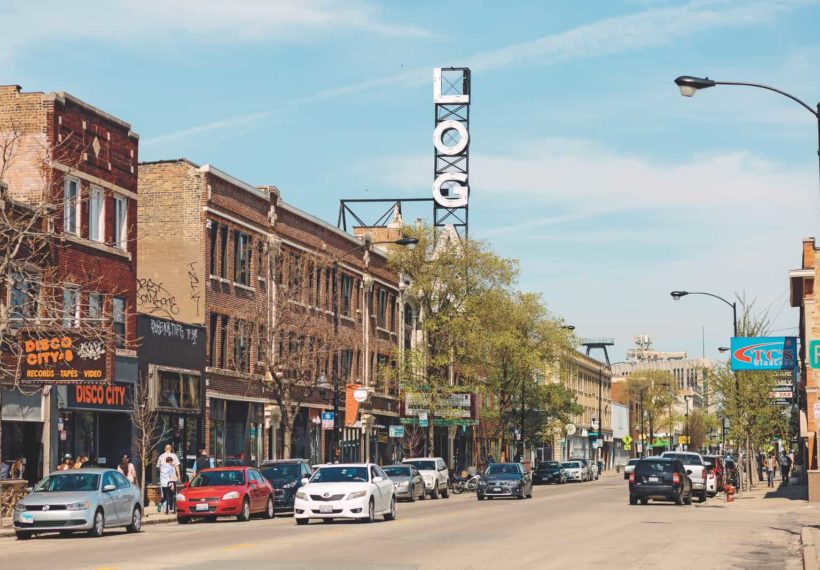
Day 3
Shopping in Logan Square and eating hummus in Lincoln Park
Last night was a late one, and a warm spring day in Chicago must not be taken for granted, so I grab some tea (Hoxton is based in the U.K., after all) from the room and head up to the pool for a pre-brunch dip.
It might seem impossible to find a place cooler than the Hoxton, but lo, it exists. It’s a part of town called Logan Square, just a 22-minute ride northwest from Fulton Market on the L’s blue line. The minute I disembark I see the signs: Tattoos? Check. Bearded dads in flannel carrying BabyBjörns? Check. A man in a floral button-down shirt on a skateboard carrying a case of Tecate? Triple check.
I’m meeting my college roommate, Michelle, who lives in Chicago these days, for brunch. Thanks in part to weddings, we see each other about once a year nowadays, but before 2016 it had been almost a decade. Unembarrassed, we long-hug in front of the height of hipster cool, Longman & Eagle, a contemporary take on ye olde public house. Inside, the wood-floored (and ceilinged!) dining room is decorated with jars of arrows, raw brick, and rusty factory lights. They’ve repurposed an old Statesman by Wurlitzer jukebox as a bussing station. Above us? Their own budget inn.
Any millennial worth her high-waisted sailor pants knows the thing to order in a place like this is the avocado toast. It’s a good choice—spread with smoked salmon ricotta, sliced avocado, and caviar, it’s more complex than the standard lemon-and-red-pepper-flake mash. Michelle, who is a maniac, orders
Nutella-banana French toast and, reasoning that this place is also a beloved whiskey bar, a What’s in a Name? cocktail, which is made from Dark Matter Coffee’s Unicorn Blood espresso blend, Mr. Black cold brew coffee liqueur, George Dickel white, and cherry bitters. I get a mimosa. We tell lots and lots of old stories, absolutely none of which will be printed here.
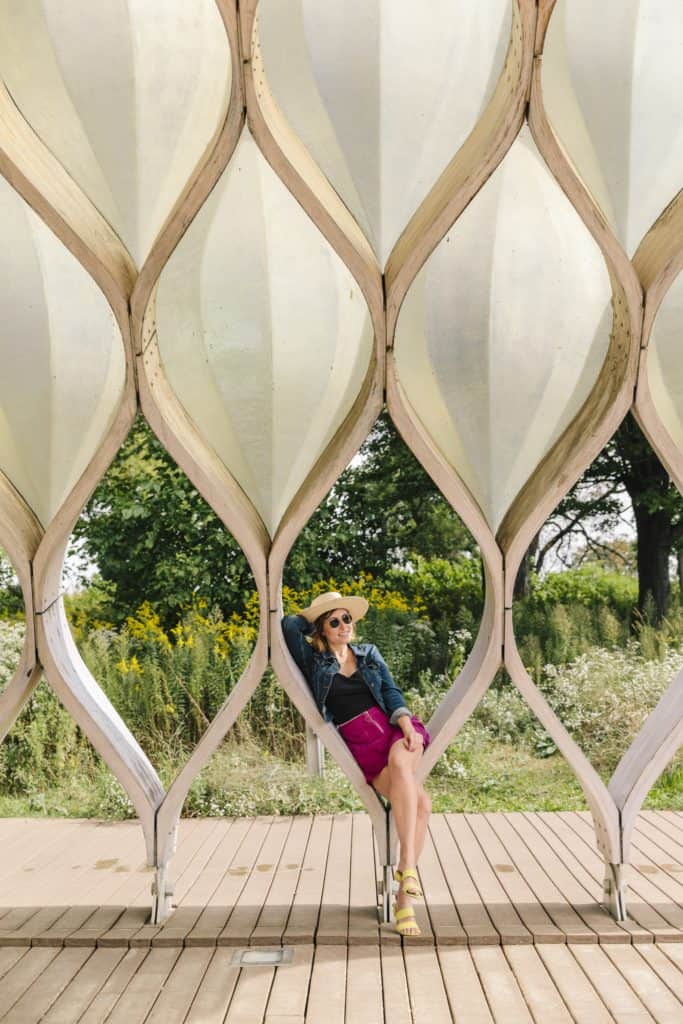
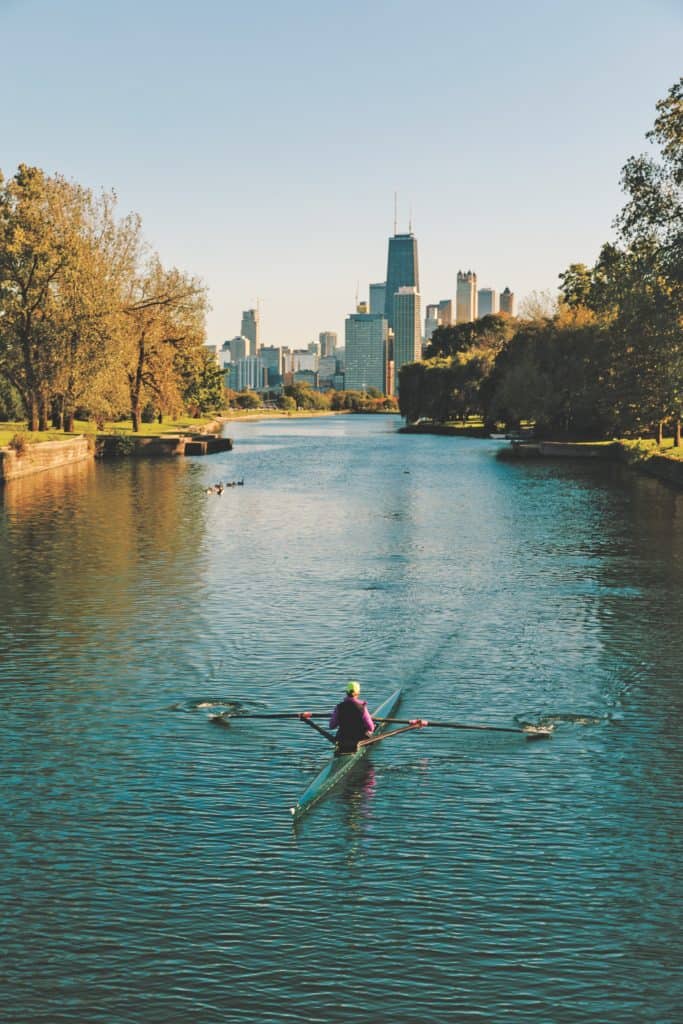
After brunch, we wander over to Wolfbait & B-girls, a female-owned and -operated shop that sells wares from Chicago artists and artisans. The name comes from a 1950s guidebook: “Wolfbait” was a term for girls who moved to Chicago looking for success; “B-girls,” for B-movie, B-side, or just bad girls, was what they sometimes became instead. We poke around the T-shirts with saucy slogans, coral rings, and candles. Michelle lifts up a studded leather bandanna and nods approvingly. I’m not sure I could pull that off, so I settle on a delicate necklace of the city’s four-star flag and a candle in an old beer can. Now all I need is a $3,000-a-month loft to put this in.
Michelle recommends City Lit, a bookstore around the corner that has a cozy reading area in front of a fireplace in the back. Among the latest nonfiction sits An American Summer by Alex Kotlowitz, which chronicles one season’s worth of life in areas of Chicago that are afflicted with gun violence. It’s a tough topic, but we agree that these stories are the most important kind.
I buy the book, and we proceed to wander down North Kedzie Boulevard admiring the greystones—majestic Romanesque homes that look like New York City’s brownstones, only they’re (usually) made out of Indiana-quarried limestone. After about a mile, we reach The 606, an elevated biking and running trail grafted onto the old Bloomingdale train line. We stroll east, looking for chef Rick Bayless’s 1,000-square-foot backyard garden, which Stephanie Izard told me was visible from the trail. We don’t see it (turns out we should have kept going all the way into Bucktown), but we do see plenty of cyclists, rooftop hangouts, and grills. If there’s one thing you can say about Chicagoans, it’s that they appreciate a nice day.
At the Western L stop, we exit the park, making plans to meet later. I get on the train, heading back to Logan Square for happy hour at Lost Lake, which was named Best American Cocktail Bar last year by the Tales of the Cocktail Foundation. Marked by a stylized metal icon of a fish and a pink neon sign that says “Tiki,” Lost Lake feels like your favorite bar from your gap year. There’s a fish tank with a skull in it. Over the bar, pink lights shine out of loose-
slatted fishing barrels. The cocktail names sound like stanzas from a poem, and I order From Pine to Palm/Like Ceremonies of a Pleasant Nature, both because I love fino sherry and because it has palo santo and pandan in it. Like all tiki drinks, it’s sweet, silly, and comes with way too many garnishes, all of which I attempt to put in my hair.
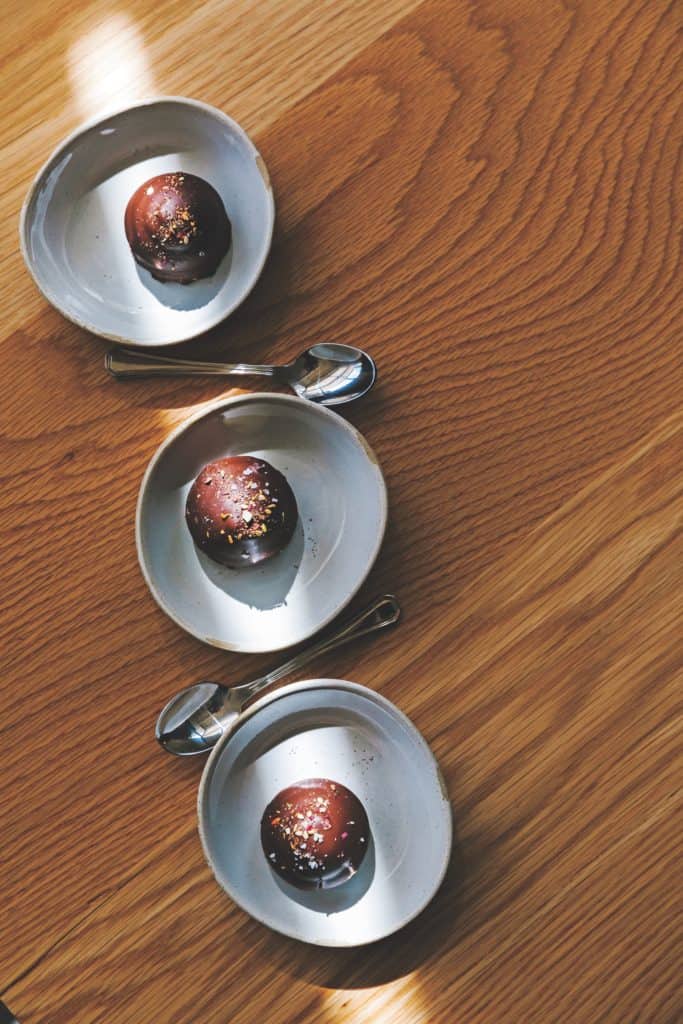
Galit is too new to have been seriously reviewed, but if it doesn’t win any awards I’ll eat my hat.
Afterward, I take a cab over to Lincoln Park, home of the very old (151 years) Lincoln Park Zoo and the very new Galit, the first restaurant that chef Zachary Engel has helmed since winning the James Beard Award for Rising Star Chef as chef de cuisine at New Orleans’s Shaya in 2017. The Middle Eastern spot is too new to have been seriously reviewed yet, but if it doesn’t win any awards I’ll eat my hat. I’d rather not, though, because the server just dropped off the airiest hummus I’ve ever had, topped with mushrooms, greens, and gribenes—crispy bits of chicken skin that are having a culinary moment. Next, fluffy, brick-oven-baked pita bread with little bowls of yogurt cheese, housemade pickles, tomato-
and-pepper spread, and little tangy onions with coriander and crumbles of oiled feta. The falafel is actually moist, served over funky fermented mango labneh. A chicken thigh comes crispy-skinned under a caramelized coat of harissa. Dessert is a classic Israeli children’s treat called krembo—a sesame shortbread cookie topped with rose-infused marshmallow and a chocolate shell—plus adults-only anise-flavored arak, which comes with a tiny glass of ice and a tiny glass of water and makes my mouth go numb. I regret that I have but one stomach to fill, but I ask my waiter to pack up the leftovers so I can bring them to my friend.
Michelle lives right down the street from Galit, and I walk over to her apartment so I can meet her cats. From her window, I can see The Wiener’s Circle, a hot dog shop notorious for its sassy, expletive-spouting employees. Michelle tells me how her whole floor had a block party in the hall on that one winter day when it was 23 below and no one was allowed to go outside. “It’s a good thing you’ve got these big ol’ windows, then,” I say, looking out at a beautiful evening. The sun is just beginning to set, painting the sky a dreamy mix of lavender and peach. There are people walking their dogs, following a pink path of fallen cherry blossoms. We see friends laughing as they wait for restaurant tables, and we hear saxophones wailing from the open doors of blues bars. The entire world in microcosm. Should we go back out? We must.
Up Next: Three Perfect Days: Auckland




